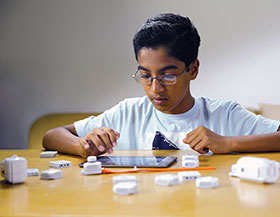

Nordic Semiconductor revealed that Pune, India-based technology startup, Plezmo, has selected Nordic’s nRF52832 Bluetooth low energy system-on-chip (SoC) for its Plezmo platform of intelligent wireless devices, designed to teach children basic wireless technology and programming skills.
The Plezmo platform is comprised of a range of programmable sensors and actuators called ‘Elements’, including gesture, proximity, colour, distance and movement sensors, a speaker, display, button and bulb, as well as speed and control motors. Each Element incorporates the nRF52832 to provide wireless connectivity to ‘Plezmo Apps’ running on Bluetooth 4.0 (and later) iOS and Android smartphones and tablets.
In operation, Plezmo Elements are designed to work with everyday objects such as existing toys, cardboard-based creations, or whatever base material the user chooses. For example, if the user wants to build a Christmas tree that lights up and starts playing music when someone approaches, they could place Plezmo bulb Elements in the tree, a speaker Element under the tree, and a proximity sensor Element on a nearby wall. From Plezmo Apps on their smartphone or tablet they can then write a program that turns the bulbs on and starts playing music via the speaker when the proximity sensor detects someone nearby.
Plezmo Apps are an extensible platform that consists of apps running on iOS and Android mobile devices, as well as desktops. The Apps offer Visual Programming as the primary interface for coding, allowing users to simply drag-and-drop coding blocks to create a logical workflow and easily troubleshoot any problems with a built-in debug capability. Plezmo Apps also include a simulator that allows users to try out their ideas in the absence of any Elements, testing different workflows to perfect their logic.
The Plezmo Elements employ 3,7 V Li-poly batteries, providing between three and four hours of continuous use between recharges, thanks in part to the ultra low power consumption of the nRF52832 SoC. The chip has been engineered to minimise power consumption with features such as the 2,4 GHz radio’s 5,5 mA peak RX/TX currents and a fully automatic power management system that reduces power consumption. The result is a Bluetooth low energy solution which offers 90 CoreMark/mA, up to twice as power efficient as competing devices.
The nRF52832 combines a 64 MHz, 32-bit ARM Cortex M4F processor with a 2,4 GHz multiprotocol radio (fully compatible with Bluetooth 4.2, ANT and proprietary 2,4 GHz RF software) featuring -96 dB RX sensitivity, with 512 KB Flash memory and 64 KB RAM.
For more information contact Andrew Hutton, RF Design, +27 (0)21 555 8400, [email protected], www.rfdesign.co.za
| Tel: | +27 21 555 8400 |
| Email: | [email protected] |
| www: | www.rfdesign.co.za |
| Articles: | More information and articles about RF Design |

© Technews Publishing (Pty) Ltd | All Rights Reserved